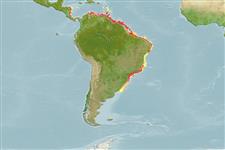>
Carangiformes (Jacks) >
Carangidae (Jacks and pompanos) > Scomberoidinae
Etymology: Oligoplites: Greek, oligos = small + Greek, hoplites = armed (Ref. 45335).
More on author: Bloch.
Environment: milieu / climate zone / distribuzione batimetrica / distribution range
Ecologia
marino; salmastro benthopelagico; distribuzione batimetrica ? - 40 m (Ref. 9626). Tropical; 16°N - 35°S, 89°W - 34°W
Western Atlantic: Laguna de Caratasca, Honduras to Montevideo, Uruguay.
Size / Peso / Age
Maturità: Lm ? range ? - ? cm
Max length : 50.0 cm TL maschio/sesso non determinato; (Ref. 5217); common length : 35.0 cm TL maschio/sesso non determinato; (Ref. 5217); peso massimo pubblicato: 900.00 g (Ref. 3277)
Adults are found over soft bottoms of the continental shelf, often inshore and in estuaries. Also pelagic and encountered throughout the water column (Ref. 9626). May feed on plankton by ram-filtering. Juveniles feed mainly on planktonic crustaceans and chaetognaths, to a minor extent on benthic crustaceans and polychaetes, besides scales taken from larger fishes (Ref. 30206, 40402). Mature females generally spawn in summer. Eggs are pelagic (Ref. 35237). Marketed mostly fresh.
Life cycle and mating behavior
Maturità | Riproduzione | Deposizione | Uova | Fecundity | Larve
Cervigón, F., 1993. Los peces marinos de Venezuela. Volume 2. Fundación Científica Los Roques, Caracas,Venezuela. 497 p. (Ref. 9626)
IUCN Red List Status (Ref. 130435: Version 2025-1)
Threat to humans
Harmless
Human uses
Pesca: scarso interesse commerciale; Acquario: Commerciale
Strumenti
Special reports
Download XML
Fonti Internet
Estimates based on models
Preferred temperature (Fonte Biblio.
123201): 22.5 - 28.1, mean 27.3 °C (based on 168 cells).
Phylogenetic diversity index (Fonte Biblio.
82804): PD
50 = 0.5312 [Uniqueness, from 0.5 = low to 2.0 = high].
Bayesian length-weight: a=0.00741 (0.00470 - 0.01169), b=2.94 (2.81 - 3.07), in cm total length, based on LWR estimates for this species & Genus-body shape (Ref.
93245).
Trophic level (Fonte Biblio.
69278): 3.8 ±0.62 se; based on food items.
Resilienza (Fonte Biblio.
120179): Medio, tempo minimo di raddoppiamento della popolazione 1.4 - 4.4 anni (Preliminary K or Fecundity.).
Fishing Vulnerability (Ref.
59153): Moderate vulnerability (40 of 100).
🛈
Nutrients (Ref.
124155): Calcium = 105 [71, 257] mg/100g; Iron = 1.22 [0.74, 2.31] mg/100g; Protein = 18.5 [17.4, 19.7] %; Omega3 = 0.244 [0.129, 0.468] g/100g; Selenium = 50.3 [27.3, 96.0] μg/100g; VitaminA = 34.7 [10.7, 88.7] μg/100g; Zinc = 1.2 [0.9, 1.7] mg/100g (wet weight);
